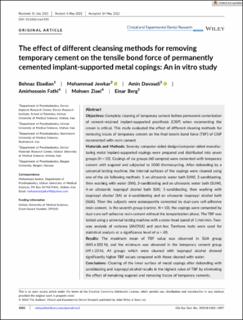The effect of different cleansing methods for removing temporary cement on the tensile bond force of permanently cemented implant-supported metal copings: An in vitro study
Journal article, Peer reviewed
Published version

Åpne
Permanent lenke
https://hdl.handle.net/11250/3017657Utgivelsesdato
2022Metadata
Vis full innførselSamlinger
Sammendrag
Objectives: Complete cleaning of temporary cement before permanent cementation of cement-retained implant-supported prosthesis (CISP) when recementing the crown is critical. This study evaluated the effect of different cleaning methods for removing traces of temporary cement on the final tensile bond force (TBF) of CISP recemented with resin cement.
Materials and Methods: Seventy computer-aided design/computer-aided manufacturing metal implant-supported copings were prepared and distributed into seven groups (N = 10). Copings of six groups (60 samples) were cemented with temporary cement with eugenol and subjected to 5000 thermocycling. After debonding by a universal testing machine, the internal surfaces of the copings were cleaned using one of the six following methods: 1-an ultrasonic water bath (UW), 2-sandblasting, then washing with water (SW), 3-sandblasting and an ultrasonic water bath (SUW), 4-an ultrasonic isopropyl alcohol bath (UA), 5-sandblasting, then washing with isopropyl alcohol (SA) or 6-sandblasting and an ultrasonic isopropyl alcohol bath (SUA). Then the subjects were subsequently cemented by dual-cure self-adhesive resin cement. In the seventh group (control, N = 10), the copings were cemented by dual-cure self-adhesive resin cement without the temporization phase. The TBF was tested using a universal testing machine with a cross-head speed of 1 mm/min. Two-way analysis of variance (ANOVA) and post-hoc Tamhane tests were used for statistical analysis at a significance level of α = .05.
Results: The maximum mean of TBF value was observed in SUA group (845 ± 203 N), and the minimum was observed in the temporary cement group (49 ± 20 N). All groups which were cleaned with isopropyl alcohol showed significantly higher TBF values compared with those cleaned with water.
Conclusions: Cleaning of the inner surface of metal copings after debonding with sandblasting and isopropyl alcohol results in the highest value of TBF by eliminating the effect of remaining eugenol and removing traces of temporary cements.
